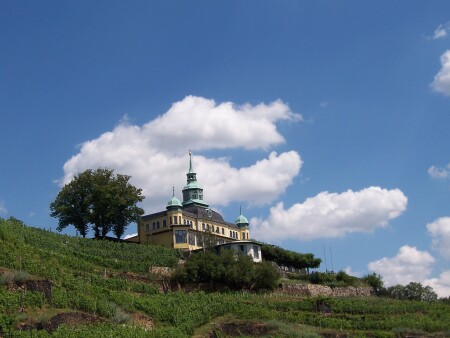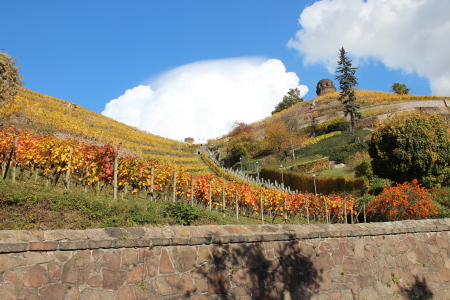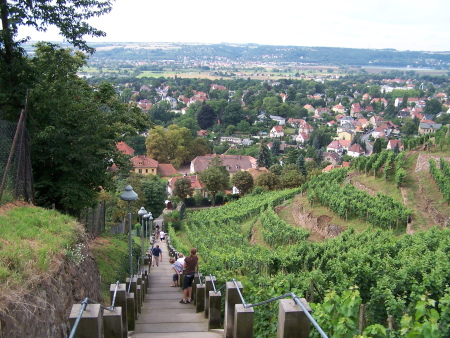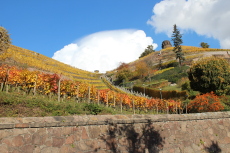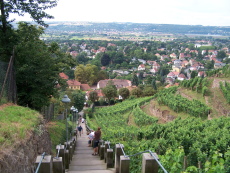Hike to the Wahnsdorfer Heights
This walk begins at the tram stop on tram line 4 "Landesbühnen Sachsen" or the stop on the narrow-gauge railway "Weißes Roß". After a short stretch on the Augustusweg, turn left onto the Mühlweg. The tracks of the Radebeul - Radeburg narrow-gauge railway, the third oldest narrow-gauge railway in Germany, run along the Mühlweg.
Passing the Lößnitztalschänke pub, you reach the junction of Weinbergstraße and Lößnitzgrundstraße. From here you already have a first view of the impressive vineyard landscape with the Hoflößnitz, the Spitzhaus and the Bismarck Tower.
You continue along Lößnitzgrundstraße to the Grundmühle, a former mill whose origins date back to the 16th century. Today it houses a restaurant. As the restaurant grounds are only accessible during opening hours, the path above the Grundmühle takes you back to the Lößnitzgrundstraße and thus to the entrance to the Lößnitzgrund.
It was laid out as a promenade path in 1880 at the suggestion of the master builder Ziller. A sandstone-walled semicircle with benches and a memorial plaque still commemorates the master builder. The Lößnitzgrund is now part of the nature trail.
After a short descent back onto Lößnitzgrundstraße, keep to the right. After approx. 200 metres, you will reach the Rieselgrundweg, on which you walk up a considerable incline to Wahnsdorf. At the top, turn right onto Gartenweg and pass some stately farms, some of which date back to the 18th century. Continue along the path until it joins Spitzhausstraße, which you turn right into.
At the end of the path, past the Birkenhof, you reach the Spitzhaus. The former pleasure and vineyard house was built in 1622 in the late Renaissance style and had a completely different appearance to today. Its most famous owners included General von Flemming and Countess Cosel. The Spitzhaus belonged to the Saxon dynasty from 1710 and returned to private ownership in 1889. After structural extensions and alterations, the Spitzhaus was opened as a restaurant in 1902. Next to the Spitzhaus is the Bismarck Tower, which was erected in honour of the former Imperial Chancellor Prince von Bismarck in 1907. The construction was financed by donations, collections and a raffle.
The Spitzhaus staircase begins a little further on. It was built between 1747 and 1750 according to designs by the master builder Pöppelmann. The staircase is also popularly known as the "year staircase" because of the number of steps. The shell pavilion forms the top of the staircase. Walking down the steps, you reach the historic ensemble of buildings of the Hoflößnitz vineyard. Hoflößnitz - founded by the Saxon court as a vineyard estate - was first mentioned in a document in 1401 and at that time only consisted of a simple half-timbered wine press and outbuildings. In 1650, the master builder Ezechiel Eckardt was commissioned by Johann Georg I to build a new mountain house, which was used for stays during the grape harvest. After changing owners several times, the Hoflößnitzverein acquired the complex in 1912 and restored it to its original state under the direction of Prof. Högg. In 1915, the municipality of Oberlößnitz bought the Berghaus and opened it in 1924 as a local history museum, now the Hoflößnitz Winery Museum. Regular exhibitions, themed wine tastings and monthly chamber concerts take place here.
From here, another flight of steps leads back to Lößnitzgrundstraße, where you turn left, cross Weinbergstraße and continue along Mühlweg on the right. This will take you back to the starting point of the walk. You can now take tram line 4 in the direction of Dresden or Weinböhla.
Details of the hike
| Distance: | ca. 4,5 km |
|---|---|
| Duration: | 2 - 2,5 Stunden |
| Height: | 120 m |
| Difficulty: | mittel - schwer |
In the brochure "Hiking trails in and around Radebeul" you will find these and many other hiking suggestions. Available from the tourist information centre.





